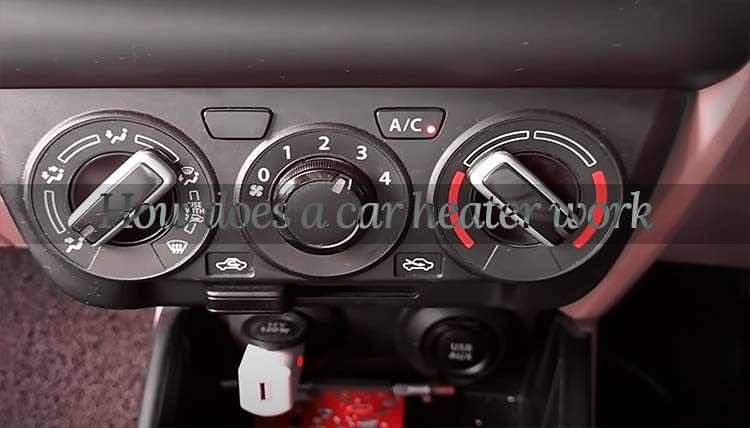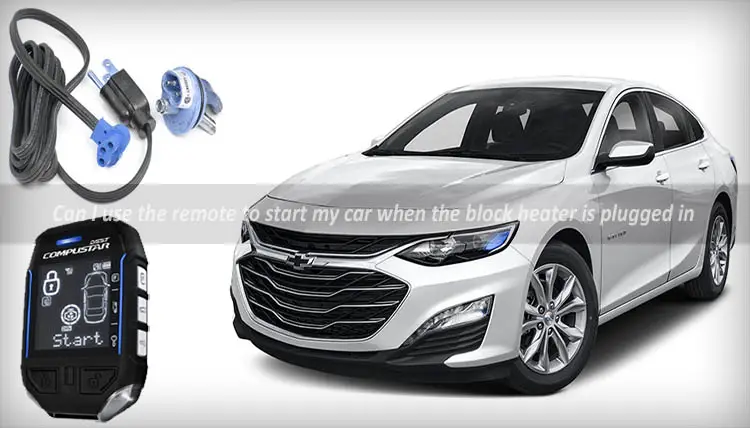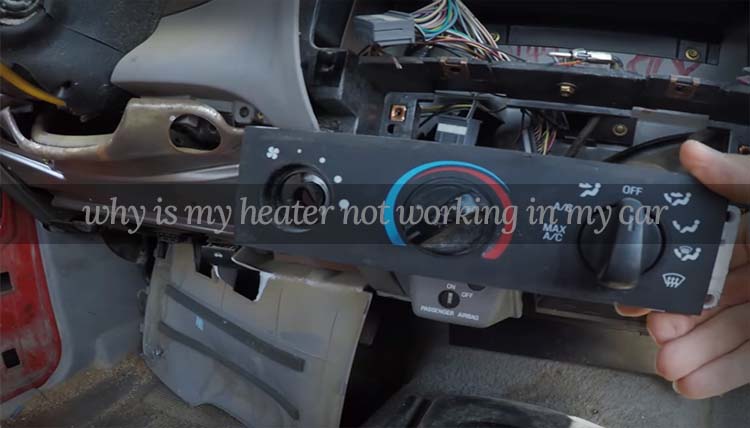When the temperature outside plummets and the frost set in, there’s nothing quite like the feeling of stepping into a toasty warm car. But have you ever paused to contemplate how precisely the heating system in your car functions? The heater core, blower fan, control panel, and heater control valve work together to generate warm air. The intricacies of these components can seem complex and enigmatic to the uninitiated.
The inner workings of a car’s heater are conducive to comfortable winter drives and essential for maintaining the car’s overall health and efficiency. Therefore, this blog post delves deep into the mechanics of car heaters, exploring the complex interaction of the system’s critical components to produce a warm and cozy atmosphere for passengers. It also sheds light on the intricate details of how car heaters work.

How does a car heater work?
Let’s delve deeper into a car heater system’s components and explore each part’s intricacies.
Heater core
At the heart of a car’s heating system is the heater core. This small but essential component is responsible for generating the heat that warms the air that flows into the car’s cabin. The heater core is positioned inside the car’s dashboard. Once the hot coolant from the engine courses through the intricately-designed network of hoses and pipes, it passes through the heater core, where heat transfer occurs.
As the coolant runs over the surface of the heater core’s finely-crafted metal fins, the warm air is then radiated out into the car’s cabin, creating a cozy environment that passengers can enjoy during the chilly winter months.
Blower fan
The blower fan is another crucial component of the car’s heating system. As the heater core generates warm air, it needs to be circulated throughout the car’s cabin. That’s where the blower fan comes in. This powerful fan draws in cool air from outside the car and passes it through the heater core, where it’s heated and then forced out through the vents and into the cabin. The blower fan is responsible for maintaining a steady flow of warm air and distributing the heat evenly throughout the car.
Control panel
The interface between the driver and the heating system is the control panel, which can take the form of dials, buttons, or digital displays that enable the driver to customize their temperature and fan speed preferences. Additionally, the control panel plays a crucial role in regulating warm air distribution throughout various sections of the car’s cabin, including the floor and the windshield.
Heater control valve
This small component plays a significant role in regulating the flow of hot coolant through the heater core. When the valve opens, hot coolant flows freely through the heater core, warming the air drawn into the car’s cabin. When the valve is closed, the flow of hot coolant is blocked, preventing warm air from being generated. The heater control valve is typically controlled by the car’s thermostat, which senses the temperature of the coolant and adjusts the valve accordingly.
Understanding the intricacies of each component of a car’s heating system is vital to maintaining a warm and cozy car cabin during the colder months. By keeping the heater core, blower fan, control panel, and heater control valve in good working order, you can ensure that your car’s heating system is functioning at its best, keeping you comfortable and safe on the road.
How can the heating system impact a car’s fuel efficiency?
Understanding the impact of a car’s heating system on fuel efficiency is a multifaceted topic that requires a nuanced understanding of the system and its components. To help shed some light on this complex issue, let’s take a closer look at some of the critical factors that can impact a car’s fuel economy when using the heating system:
The heating system’s reliance on engine heat
As we discussed earlier, a car’s heating system relies on hot coolant from the engine to produce warm air. This means that the engine has to work harder and burn more fuel in order to produce the heat needed to warm the car. This impact can be particularly pronounced in older cars, where the heating system may be less efficient and require more energy to produce the same heat level.
The length of time the heating system is in use
While using the heating system for a short period may not significantly impact a car’s fuel efficiency, extended use can start to add up. This is particularly true for drivers who live in colder climates and rely on their car’s heating system for extended periods throughout the winter. In these cases, the impact on fuel efficiency can be particularly noticeable.
The impact of the blower fan on the fuel efficiency
While the blower fan is a crucial component of the heating system, it can also significantly impact a car’s fuel economy. This is because the fan draws power from the car’s electrical system, which can strain the engine and reduce fuel efficiency.
The importance of regular maintenance
Proper maintenance of the heating system is crucial for ensuring that it runs at maximum efficiency and minimizing its impact on a car’s fuel economy. Regular maintenance tasks such as flushing the coolant and changing the filter can help to ensure that the system works as efficiently as possible.
The driver’s role in minimizing the impact on the fuel efficiency
Finally, it’s important to note that drivers can take steps to reduce the impact of the heating system on their car’s fuel economy. This includes using the system in moderation, turning it off when it’s not needed, and taking other steps to reduce the strain on the engine and electrical system.
By understanding these key factors and taking steps to maintain and moderate the use of the heating system properly, drivers can minimize the impact on their car’s fuel efficiency while still staying warm and comfortable on the road.
Common issues with car heaters
Understanding the common issues with car heaters, how to diagnose and fix them, and when to seek professional help can help drivers avoid potential hazards and save money on repairs.
Common problems with car heaters
- Blower motor failure: This is one of the most common issues with car heaters. When the blower motor fails, it can result in reduced airflow or no airflow at all, making the cabin uncomfortably cold. This is often caused by a blown fuse, faulty wiring, or a worn-out motor.
- Lack of hot air: When a car’s heater blows cold air, it’s usually due to a clogged heater core, faulty thermostat, or low coolant levels.
- Weird noises: Squealing, rattling, or clicking sounds coming from the heater can be caused by a worn-out fan belt, broken fan blades, or a failing blower motor.
How to diagnose and fix these issues?
- Blower motor failure: Check the fuses and wiring for any signs of damage or wear. If everything appears in good condition, the blower motor must be replaced.
- Lack of hot air: Start by checking the coolant levels and ensuring that the thermostat is functioning correctly. If these components are in good working condition, then the heater core may need to be cleaned or replaced.
- Weird noises: A mechanic can quickly diagnose the cause of the noise and make the necessary repairs.
When to seek professional help for car heater problems
While some car heater issues can be fixed with basic knowledge and a few tools, more complicated problems may require the attention of a professional. If the issue is beyond your expertise or if you’re not comfortable working with electrical components, it is highly recommended to solicit a licensed mechanic.
Additionally, if you notice any signs of leaking coolant, strange odors, or a burning smell coming from the heater, it’s essential to seek professional help immediately.
You may also like: How to turn on the heater in a car and stay comfortable?
FAQS
Does the car heater work with the engine off?
No, a car heater typically does not work with the engine off. The heater is a component of the car’s cooling system, which requires the engine to be running to circulate the coolant through the engine and into the heater core. Without the engine running, no hot coolant produces heat for the heater core, meaning no warm air will flow into the car’s cabin. However, some newer cars may have an electric heater that can provide heat even when the engine is off, but this is not a common feature.
What are the key differences between ac and heater in the car?
When it comes to air conditioning (AC) and heaters in cars, there are a few key differences. AC systems are designed to cool the air inside the car, while heaters are designed to warm it up. AC systems work by compressing and expanding a refrigerant, which absorbs heat from the air and releases it outside the car. Heaters work by passing air over a hot engine coolant that flows through a heater core, which warms up the air before it enters the cabin. While both systems help regulate the temperature inside the car, they operate differently and have different functions.
What to do when the car heating system is not working?
If the heating system in your automobile is not functioning optimally, several rudimentary troubleshooting techniques can be attempted to mitigate the problem. Start by checking the coolant levels and ensuring that the thermostat is functioning correctly. If these components are in good working condition, then the heater core may need to be cleaned or replaced.
Additionally, ensure the blower fan is working and that the control panel and the heater control valve are adjusted to the appropriate settings. If none of these solutions work, it’s best to seek professional help from a licensed mechanic who can diagnose and fix the issue. Regular maintenance and prompt attention to any issues can help prevent car heater problems in the future.
Does car heating use fuel?
When a car’s heater is turned on, it draws heat from the engine coolant system and blows it into the cabin. This process requires energy, and the engine needs to burn more fuel to generate that energy. Therefore, the more you use your car’s heater, the more fuel your car will consume. However, the impact on fuel consumption is relatively minor, and it’s not usually something that drivers need to worry about.
Conclusion
In frigid weather, a car heater is a crucial and pivotal component of the vehicle, acting as the harbinger of warmth and comfort for drivers and passengers alike. The harmonious coordination between the heater core and blower fan generates toasty air that is proficiently regulated through the dexterity of the control panel and heater control valve. By drawing heat from the engine coolant system and propelling it into the cabin, the car’s fuel efficiency undergoes a notable impact. But, with scheduled maintenance and conscientious care, the car heater delivers optimal and consistent performance for extended durations.



